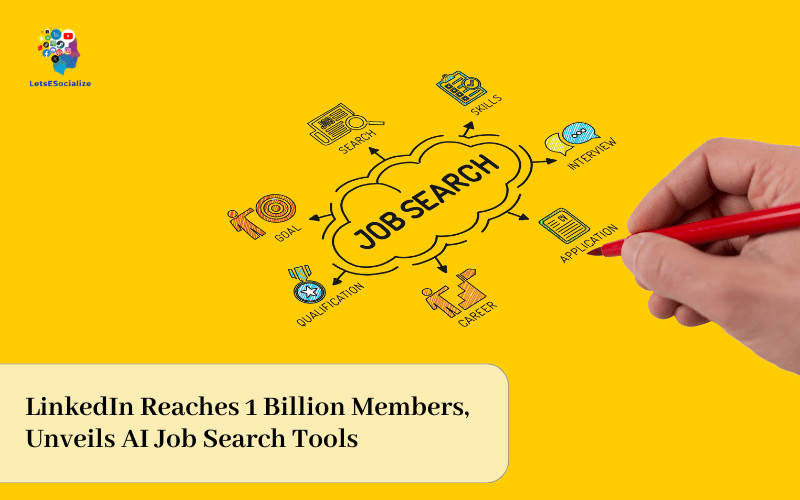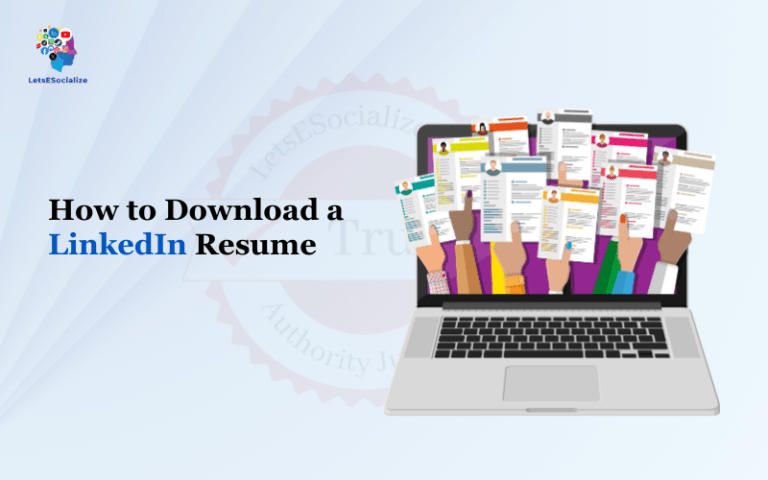LinkedIn, the Microsoft-owned professional networking platform, has achieved a major milestone by surpassing 1 billion members globally. This cements its position as the world’s largest professional community.
To mark this achievement and continue improving services for its growing user base, LinkedIn has introduced new artificial intelligence (AI) powered features aimed at enhancing the job search experience. These include AI-generated job recommendations personalized to each member’s profile and skills.
In this post, we’ll cover LinkedIn crossing the 1 billion member mark, its journey over the past 19 years, the AI job search tools launched, and its impact on professionals and businesses.
Table of Contents
LinkedIn Reaches 1 Billion Members
In September 2022, LinkedIn officially announced that it has reached a mammoth 1 billion members globally on its platform. This makes it only the third social media platform to hit this major user base milestone after Facebook and YouTube.
To put this number into perspective, LinkedIn now has more members than the entire populations of the United States, Canada and Australia combined!
The massive user base highlights LinkedIn’s popularity as the go-to platform for professionals across the world. From students to experienced candidates, 1 in 3 of the global workforce is now on LinkedIn in some form.
The company was founded back in 2002 and has seen steady growth over the years. However, the growth has accelerated significantly in the last few years.
- LinkedIn took around 4 years to go from 100 million to 200 million users
- But it added its 900th millionth member within less than 2 years
This exponential growth can be attributed to remote work and increased digitalization of the job market over the past few years. Especially after the pandemic accelerated these trends hugely.
Professionals now rely more on digital networks not just for job hunting but also for brand building, market research, lead generation and more. LinkedIn provides features that cater perfectly to these needs.
Also read: 7 Latest LinkedIn Updates Coming In 2023
Reid Hoffman, LinkedIn’s co-founder, expressed his delight at this milestone and thanked the members for their trust in the platform.
With 1 billion members in more than 200 countries, LinkedIn still has plenty of room to expand further. It aims to continue innovating and adding features to improve the experience for users.
LinkedIn Rolls Out New AI Tools for Job Seekers
Along with announcing the 1 billion member achievement, LinkedIn also unveiled new AI-powered tools on their platform. These tools aim to utilize technology like machine learning and AI to improve matching between talent and opportunities.
Here are some of the key new job search features LinkedIn is rolling out:
AI-Generated Profile Summary
This feature uses AI to review a member’s profile and work experience. It then generates a professional summary optimized for recruiters and hiring managers.
The AI considers details like your position titles, companies worked at, skills listed and more. Then it summarizes all this into a short professional pitch for your profile.
This makes it easier for members to quickly create an effective profile summary without much effort. You can simply review the AI generated summary, make edits if needed and add it to your profile.
Skill Recommendations
LinkedIn will use machine learning algorithms to analyze your profile – including past positions, education, skills and interests. Based on this, it will recommend relevant skills that you can add to your profile.
This helps improve your discoverability for recruiters searching for specific skills. As a job seeker, you can also identify skill gaps that you can work on.
Improved Job Matching
The platform is revamping its job search algorithm to provide more tailored recommendations. When you search for a job on LinkedIn, it will analyze your profile, skills, preferences and other signals.
Based on this analysis, you will see job listings that closely match your profile and search query. This improves your chances of finding a job that is a good fit.
Salary Insights
LinkedIn aims to make salary information more transparent for job seekers. Members will now be able to access aggregated salary ranges for specific job titles.
You can search for a job title and location, and view the typical salary range based on data from LinkedIn profiles. This gives you a benchmark to evaluate job offers and negotiate better pay during hiring.
Also read: How to Create a LinkedIn Account: The Ultimate Guide for Beginners and Experts
Benefits of LinkedIn’s New AI Tools for Job Seekers
The AI-powered job search features provide some key benefits for candidates and make job hunting much more efficient:
- Better recommendations – The improved job matching algorithm will surface jobs that align closely with your actual profile, skills and preferences. This means spending less time sifting through irrelevant listings.
- Skill development – The skill recommendations allow you to identify skill gaps you can work on to advance your career. Having the right skills on your profile also makes you more discoverable.
- Profile building – Tools like the AI profile summary take away the hassle of writing an effective profile. The data-driven approach results in a summary tailored specifically for recruiters.
- Salary insights – Candidates now have a reference point for typical salary ranges. This puts them in a stronger position when negotiating job offers and pay.
- Wider reach – With 1 billion members, job seekers are now much more discoverable across a massive global talent pool. Recruiters have access to more profiles.
- Reduced bias – AI based recommendations look at actual skills and experience objectively. This can help reduce unconscious human bias during hiring.
Overall, the AI tools create a more data-driven and transparent job-hunting process. Job seekers on LinkedIn will find it easier to identify opportunities, showcase skills accurately and negotiate better.
Also read: 7 Latest LinkedIn Updates Coming In 2023
Impact of 1 Billion Users and AI Job Tools for LinkedIn
Achieving 1 billion members and introducing AI job search marks an important milestone for LinkedIn with major implications:
Unmatched Data to Improve AI Models
With profiles from 1 billion professionals, LinkedIn has unmatched data to train its AI models. As the algorithms learn from more data points, the personalized insights will become more accurate.
Increased Monetization of Active User Base
While it has 1 billion total members, LinkedIn reports over 810 million monthly active users. With the helpful AI tools, it can further monetize this large engaged base via premium subscriptions, recruitment solutions and ads.
Competition for Talent Acquisition Intensifies
AI-powered job matching creates new competition for traditional job boards and company career sites. Candidates may prefer LinkedIn’s tailored recommendations.
Concerns Around Bias and Transparency
Using AI to surface job opportunities raises some risks around bias in algorithms or results. LinkedIn will need to ensure fairness and transparency.
New Features Announced by LinkedIn
In separate news, LinkedIn recently announced some other upcoming features:
- Events – A new events experience to help members network offline. Discover, create, share, and register for professional events.
- Newsletters – Publishers and creators can now turn their LinkedIn content into customizable newsletters using existing posts.
- Funnel Analytics – A new analytics dashboard for marketers to track engagement across different LinkedIn surfaces like ads, posts, Pages, and Groups. Provides insights to optimize campaign funnel.
- New Admin Tools – Additional tools for Company Page admins including previewing posts as employees, monitoring visitor comments, and user roles. Makes managing Pages easier.
These features will help enrich the LinkedIn platform with more ways to engage professionals. Now let’s quickly round up the key highlights.
Also read: How to Change LinkedIn Password
Conclusion and Summary
In summary, here are the key points:
- LinkedIn has reached the major milestone of 1 billion member accounts globally.
- Over 19 years, it has expanded services and grown rapidly, especially after the Microsoft acquisition.
- New AI-powered features are aimed at helping members find optimal career opportunities.
- Personalized job recommendations, salary insights, and skills assessments leverage AI.
- 1 billion users provide immense data to train algorithms and improve personalization.
- LinkedIn can monetize active members further through premium offerings.
- But AI job matching creates competition for other channels and raises transparency concerns.
In conclusion, LinkedIn hitting 1 billion users and introducing AI job search tools represents a significant evolution in professional networking and recruitment. But the company will need to manage risks around bias, transparency, and market impact responsibly as it taps into new opportunities.
Frequently Asked Questions
Here are some common FAQs about LinkedIn’s 1 billion users milestone and new job search features:
-
Which countries have the most LinkedIn members currently?
Currently the top 3 countries by LinkedIn membership are:
United States – 196 million
India – 82 million
Brazil – 49 million -
Does LinkedIn charge any fees for user profiles?
Having a basic LinkedIn profile is free for all members. Premium subscriptions with additional features are priced starting at $29/month. But a free profile is enough for most job seekers.
-
How accurate is the AI profile summary generator?
The AI considers your work history and profile details to create a summary. You can edit the generated text if needed. Overall, it provides a good starting point you can tweak as required.
-
Can I opt out of LinkedIn using my data for recommendations?
Yes, you can manage data sharing from your account settings. Disable options like “Let LinkedIn use your data to make recommendations” if needed.
-
Is the salary estimate accurate for all locations?
The salary insights are based on actual salaries entered by members in that location. So for major cities, the estimates are quite accurate overall.






